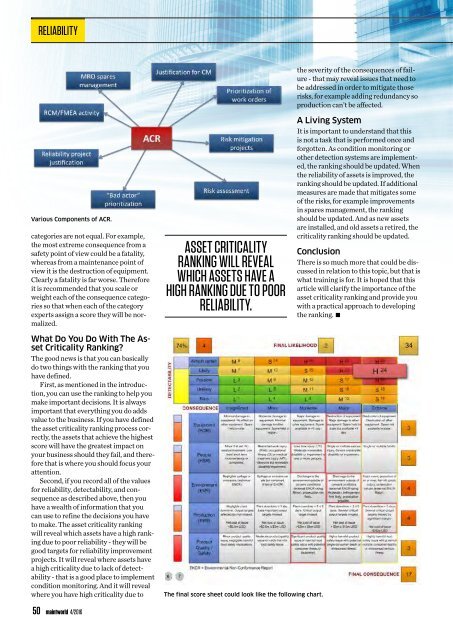Maintworld 4/2016
In this issue: Towards Better Asset Performance Modelling Paper Mills’ Planned Maintenance Approach Ultrasound in Asset Condition Management Asset Criticality Ranking
In this issue:
Towards Better Asset Performance Modelling
Paper Mills’ Planned Maintenance Approach
Ultrasound in Asset Condition Management
Asset Criticality Ranking
You also want an ePaper? Increase the reach of your titles
YUMPU automatically turns print PDFs into web optimized ePapers that Google loves.
RELIABILITY<br />
Various Components of ACR.<br />
categories are not equal. For example,<br />
the most extreme consequence from a<br />
safety point of view could be a fatality,<br />
whereas from a maintenance point of<br />
view it is the destruction of equipment.<br />
Clearly a fatality is far worse. Therefore<br />
it is recommended that you scale or<br />
weight each of the consequence categories<br />
so that when each of the category<br />
experts assign a score they will be normalized.<br />
ASSET CRITICALITY<br />
RANKING WILL REVEAL<br />
WHICH ASSETS HAVE A<br />
HIGH RANKING DUE TO POOR<br />
RELIABILITY.<br />
the severity of the consequences of failure<br />
- that may reveal issues that need to<br />
be addressed in order to mitigate those<br />
risks, for example adding redundancy so<br />
production can’t be affected.<br />
A Living System<br />
It is important to understand that this<br />
is not a task that is performed once and<br />
forgotten. As condition monitoring or<br />
other detection systems are implemented,<br />
the ranking should be updated. When<br />
the reliability of assets is improved, the<br />
ranking should be updated. If additional<br />
measures are made that mitigates some<br />
of the risks, for example improvements<br />
in spares management, the ranking<br />
should be updated. And as new assets<br />
are installed, and old assets a retired, the<br />
criticality ranking should be updated.<br />
Conclusion<br />
There is so much more that could be discussed<br />
in relation to this topic, but that is<br />
what training is for. It is hoped that this<br />
article will clarify the importance of the<br />
asset criticality ranking and provide you<br />
with a practical approach to developing<br />
the ranking.<br />
What Do You Do With The Asset<br />
Criticality Ranking?<br />
The good news is that you can basically<br />
do two things with the ranking that you<br />
have defined.<br />
First, as mentioned in the introduction,<br />
you can use the ranking to help you<br />
make important decisions. It is always<br />
important that everything you do adds<br />
value to the business. If you have defined<br />
the asset criticality ranking process correctly,<br />
the assets that achieve the highest<br />
score will have the greatest impact on<br />
your business should they fail, and therefore<br />
that is where you should focus your<br />
attention.<br />
Second, if you record all of the values<br />
for reliability, detectability, and consequence<br />
as described above, then you<br />
have a wealth of information that you<br />
can use to refine the decisions you have<br />
to make. The asset criticality ranking<br />
will reveal which assets have a high ranking<br />
due to poor reliability - they will be<br />
good targets for reliability improvement<br />
projects. It will reveal where assets have<br />
a high criticality due to lack of detectability<br />
- that is a good place to implement<br />
condition monitoring. And it will reveal<br />
where you have high criticality due to<br />
The final score sheet could look like the following chart.<br />
50 maintworld 3/<strong>2016</strong> 4/<strong>2016</strong>

















